 W
W$50SAT is an American amateur radio satellite. It was launched on November 21, 2013 with a Dnepr rocket from the Dombarovsky Air Base, in Orenburg, Russia.
 W
WAMSAT-OSCAR 7, or AO-7, is the second Phase 2 amateur radio satellite constructed by the Radio Amateur Satellite Corporation or AMSAT. It was launched into Low Earth Orbit on November 15, 1974 and remained operational until a battery failure in 1981. Then after 21 years of apparent silence, the satellite was heard again on June 21, 2002 – 27 years after launch. At that time the public learned that the satellite had remained intermittently functional and was used surreptitiously for communication by the anticommunist opposition Fighting Solidarity during the martial law in Poland.
 W
WAMSAT OSCAR 10 was a star-shaped German AMSAT micro-satellite. It was launched on 16 June 1983 from Guiana Space Centre, Kourou, French Guiana, with an Ariane 1 rocket. This was changed to a Molniya orbit using an attached booster, to support world-wide amateur satellite communications.
 W
WAMSAT-OSCAR 51 or AO-51 is the in-orbit name designation of a now defunct LEO amateur radio satellite of the OSCAR series; formerly known as ECHO, built by AMSAT. It was launched on June 29, 2004 from Baikonur Cosmodrome, Kazakhstan on a Dnepr launch vehicle. It is in sun synchronous low Earth orbit.
 W
WThe Bluesat project is an engineering project being undertaken by undergraduate students at the University of New South Wales. It aims to raise awareness of space and give students the opportunity to undertake space engineering projects.
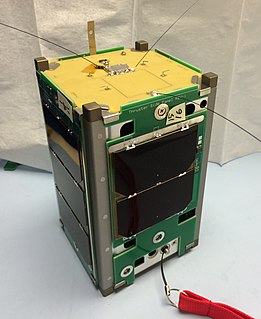 W
WBRICSat-2, or USNAP1, is an experimental amateur radio satellite from the United States Naval Academy that was developed in collaboration with George Washington University. BRICSat-2 is the successor to BRICSat-P. AMSAT North America's OSCAR number administrator assigned number 103 to this satellite; in the amateur radio community it is therefore also called Navy-OSCAR 103, short NO-103.
 W
WDelfi-C3 is a CubeSat satellite constructed by students at the Delft University of Technology in the Netherlands. It is a 3-unit CubeSat, and was launched at 03:53:42 on 28 April 2008, as part of the NLS-4 mission, aboard a PSLV rocket, from the Second Launch Pad at the Satish Dhawan Space Centre in India. The launch was contracted by ISRO, through Antrix Corporation and UTIAS.
 W
WDiwata-2 or Diwata-2B is a Philippine microsatellite launched on October 29, 2018. It is the first satellite launched under the STAMINA4Space program.
 W
WDove-OSCAR 17 is a Brazilian educational and amateur radio satellite (BRAMSAT) (AMSAT-BRAZIL) launched on 22 January 1990.
 W
WFalconSAT is the United States Air Force Academy's (USAFA) small satellite engineering program. Satellites are designed, built, tested, and operated by Academy cadets. The project is administered by the USAFA Space Systems Research Center under the direction of the Department of Astronautics. Most of the cadets who work on the project are pursuing a bachelor of science degree in astronautical engineering, although students from other disciplines join the project.
 W
WThe Joint Air Force-Weber State University Satellite (JAWSAT) is an American military mini-satellite launched aboard a Minotaur rocket on January 27, 2000 from Vandenberg Air Force Base (VAFB) in California. After its own launch, JAWSAT deployed four microsatellites: FalconSAT-1, OCSE, OPAL, and ASUSat. JAWSAT also carried NASA's Plasma Experiment Satellite Test (PEST).
 W
WKedr also known as ARISSat 1 and RadioSkaf-2, was an amateur radio minisatellite operated by RKK Energia as part of the Amateur Radio on the International Space Station and RadioSkaf programmes. A follow-up to the SuitSat spacecraft, Kedr was launched to commemorate the fiftieth anniversary of the Vostok 1 mission.
 W
WKITSAT-1 or KITSAT-A is the first satellite to be launched for the South Korea. Once launched, the satellite was given the nickname "Our Star". The KITSAT-1 is a low Earth orbit (LEO) satellite with a modular structure. Of the 12 satellites launched by South Korea, KITSAT-1 has the highest altitude. While the KITSAT-1 maintains equilibrium by gravity gradient forces, magnetic torque can be used to control attitude if needed. The forecasted lifespan of the KITSAT-1 was only five years, but communication with the satellite was maintained for 12 years. Since the launch of the KITSAT-1, South Korea has launched an additional 36 satellites.
 W
WKiwiSAT, an amateur radio satellite developed by AMSAT-ZL, is to be New Zealand's first satellite. It is being designed and built by New Zealand radio amateurs supported by Massey University (Auckland) and various corporate sponsors.
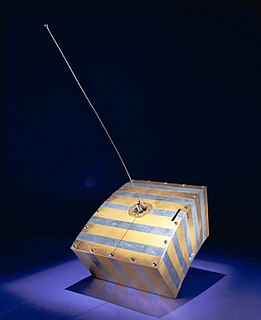 W
WOSCAR I is the first amateur radio satellite launched by Project OSCAR into low Earth orbit. OSCAR I was launched December 12, 1961, by a Thor-DM21 Agena B launcher from Vandenberg Air Force Base, Lompoc, California. The satellite, a rectangular box weighing 10 kg., was launched as a secondary payload (ballast) for Corona 9029, also known as Discoverer 36, the eighth and final launch of a KH-3 satellite.
 W
WOSCAR II is the second amateur radio satellite launched by Project OSCAR into Low Earth orbit. OSCAR II was launched June 2, 1962, by a Thor-DM21 Agena B launcher from Vandenberg Air Force Base, Lompoc, California. The satellite, a rectangular box weighing 10 kg (22 lb), was launched as a secondary payload (ballast) for Corona 43, the fifth launch of a KH-4 satellite.
 W
WOSCAR 3 is the third amateur radio satellite launched by Project OSCAR into Low Earth Orbit. OSCAR 3 was launched March 9, 1965 by a Thor-DM21 Agena D launcher from Vandenberg Air Force Base, Lompoc, California. The satellite, massing 15 kg (33 lb), was launched piggyback with seven United States Air Force satellites. Though the satellite's active life was limited to sixteen days due to battery failure, OSCAR 3 relayed 176 messages from 98 stations in North America and Europe during its 274 orbit life-time -- the first amateur satellite to relay signals from Earth. As of 2021, it is still in orbit.
 W
WOSCAR IV was the fourth amateur radio satellite launched by Project OSCAR and the first targeted for Geostationary orbit on 12 December 1965. The satellite was launched piggyback with three United States Air Force satellites on a Titan IIIC launch vehicle. Due to a booster failure, OSCAR 4 was placed in an unplanned and largely unusable Geostationary transfer orbit; however, OSCAR 4 did facilitate the first direct satellite communication between the United States and the Soviet Union.
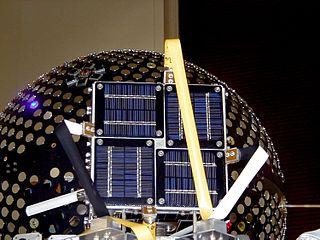 W
WOSCAR 44 is an American amateur radio satellite for packet radio. It was built at the U.S. Naval Academy.
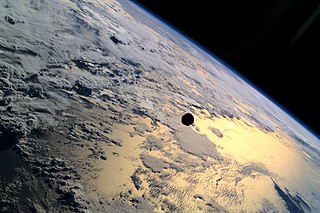 W
WPANSAT was an amateur radio satellite. It was launched by Space Shuttle Discovery during the STS-95 mission as part of the third International Extreme Ultraviolet Hitchhiker (IEH-3) mission, on 30 October 1998 from Kennedy Space Center, Florida.
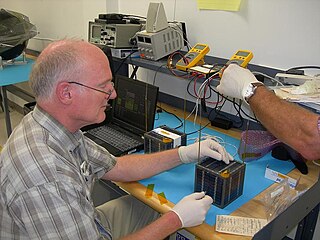 W
WRadar Fence Transponder was an amateur radio satellite that was developed and built for training purposes at the United States Naval Academy. The 3 kg (6.6 lb) heavy RAFT had a cubic structure of 12.7 cm (5.0 in) edge length and therefore did not meet the Cubesat standard. Solar cells on all six sides of the satellite were used to supply energy. It had neither position control nor drive systems.
 W
WSAPPHIRE was a satellite built by the Stanford University students in Palo Alto, California.
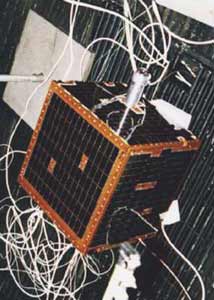 W
WSEDSAT-1 is a U.S. amateur radio satellite built by students and developed at the University of Alabama in Huntsville (UAH).
 W
WSRMSAT is a Nanosatellite built by students at Sri Ramaswamy Memorial University(SRM Institute of Science and Technology, Chennai) in India. The satellite is an Indian Technology demonstration and Earth observation satellite which is operated by the SRM Institute of Science and Technology. This nanosatellite was used to monitor Greenhouse gases in atmosphere.
 W
WThe STARSHINE series of three artificial satellites were student participatory missions sponsored by the United States Naval Research Laboratory.
 W
WStarshine 3 is one of five satellites in the Starshine project.
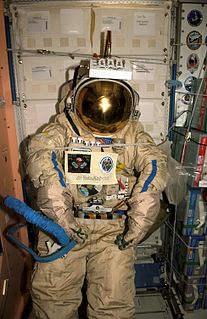 W
WSuitSat was a retired Russian Orlan spacesuit with a radio transmitter mounted on its helmet. SuitSat-1 was deployed in an ephemeral orbit around the Earth on February 3, 2006. The idea for this novel OSCAR satellite was first formally discussed at an AMSAT symposium in October 2004, although the ARISS-Russia team is credited with coming up with the idea as a commemorative gesture for the 175th anniversary of the Moscow State Technical University.